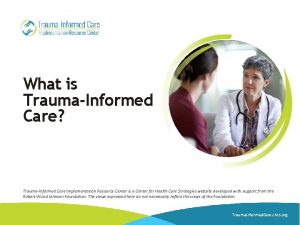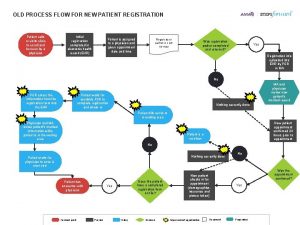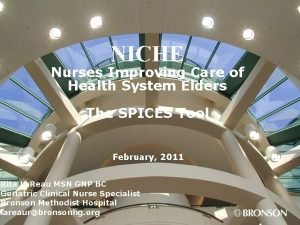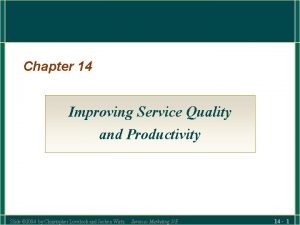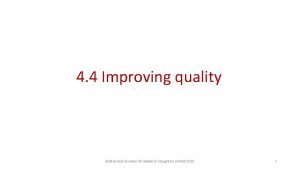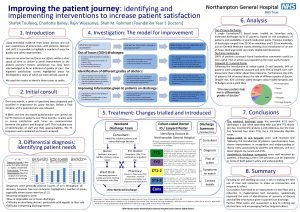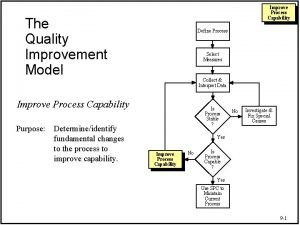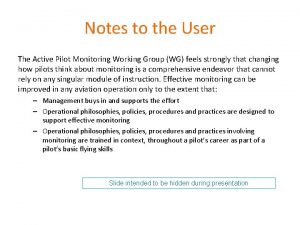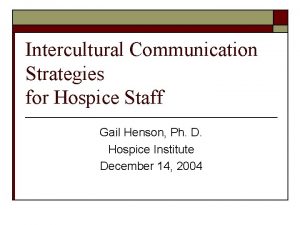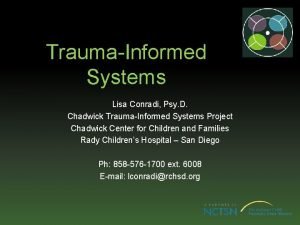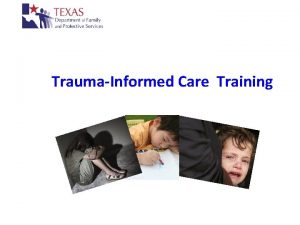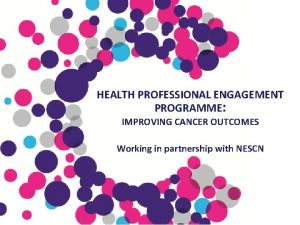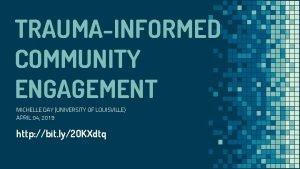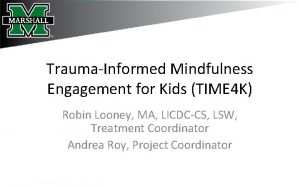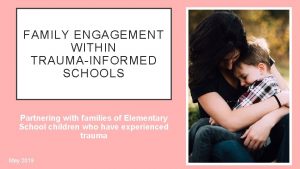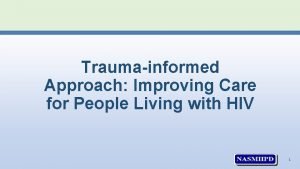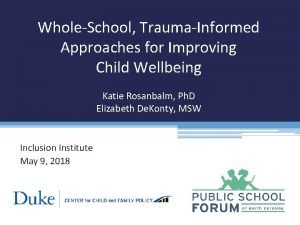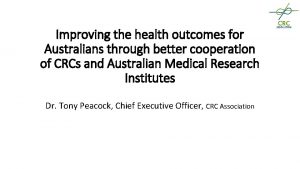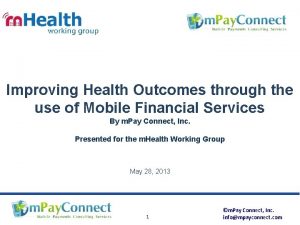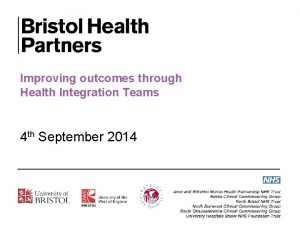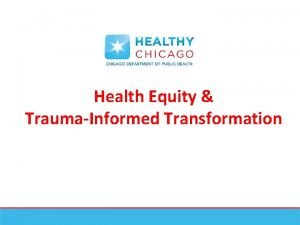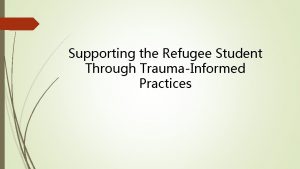Engagement Population Health Improving Health Outcomes Through TraumaInformed





































- Slides: 37

Engagement & Population Health: Improving Health Outcomes Through Trauma-Informed Culture and Practice Yves Ades, Ph. D. - Ades Integrated Health Strategies Bradley Jacobs, LCSW - The Coalition for Behavioral Health

Agency’s Core Values Continuous Quality Improvement Agency engages in an ongoing effort to improve its services and internal practices. Respect Agency acts on its belief in the essential dignity and value of each individual by treating everyone with compassion, caring and courtesy. Maximize Individual Potential Agency works with people to help them reach their individual potential. Supportive Environment Agency believes that people need each other to achieve their goals, and creates a supportive environment where people can share ideas and information freely to foster creativity, communication and collaboration. Integrity Agency is committed to acting with integrity, as demonstrated by treating people consistently, honestly and fairly to help them achieve their own goals and the goals of the agency

Recovery In a study of the long-term outcomes of individuals diagnosed with schizophrenia, people were asked what made the most difference in their struggles toward recovery. The number one reason people gave was “someone believed in me. ” -Courtney Harding

Defining Recovery • Recovery refers to the process in which people are able to live, work, learn, and participate fully in their communities. • For some individuals, recovery is the ability to live a fulfilling and productive life despite a disability. • For others, recovery implies the reduction or complete remission of symptoms. Science has shown that having hope plays an integral role in an individual's recovery.

Characteristics of Recovery Based Practice (RBP) RBP is characterized by being a person-driven and strengths-based approach. RBP practitioners believe that all people are capable of growth and change. RBP practice starts where the person is at and works toward the person’s own goals. RBP provides support through encouragement and creates opportunities for connection and success.

Recovery Based Practice is about… Forming relationships with people, not just making diagnoses Helping to rebuild lives, not just treat symptoms Treating people like they are capable of self-direction and growth, not as incapacitated patients Forming real emotional relationships, not artificial treatment relationships Hope, empowerment, self-responsibility and respect, community integration, and fighting stigma

Trauma Training Overview: • Define Trauma • Child Traumatic Stress • Long-term Effect of Trauma • Trauma, the Brain, and the Body • Trauma Informed Care • Compassion Fatigue

Prevalence of Trauma More than 50% adults experienced or exposed to violence (VA) Hx of substance use – high rates of trauma exposure (Covington, Hopper) Exposure starts at young age Individuals diagnosed with SMI – 90%+ report hx of trauma (Mueser et al)

What is trauma? • • A traumatic event is one in which a person experiences (witnesses or is confronted with): • Actual or threatened death • Serious injury • Threat to physical integrity of self or another Responses to a traumatic event may include • Intense fear • Helplessness • Horror • Attachment • • (Marcenich, 2009) Copyright 2012 Trauma Informed Care Stakeholders Group Training Subcommittee

Cognitive Triad of Traumatic Stress Views about the world Views about the future Views about the self SAMHSA. Trauma-Informed Care in Behavioral Health Services. Treatment Improvement Protocol (TIP) Series 57. HHS Publication No. (SMA) 14 -4816. Rockville, MD: SAMHSA, 2014.

Effects on health / biology “Trauma affects the entire human organism – mind, body, and brain. Healing… means being able to … restore the entire organism to safety. ” van der Kolk, The Body Keeps the Score

Impact of Childhood Trauma A report of child abuse is made every ten seconds in the United States. (Childhelp, 2013) Children who experience child abuse and neglect are 59% more likely to be arrested as a juvenile, 28% more like to be arrested as an adult, and 30% more likely to commit a violent crime. (Child Welfare Information Gateway, 2006)

Child Traumatic Stress • Child traumatic stress is the physical and emotional response a child has to events that pose a threat to the child or someone important to them • When a child experiences trauma, the child may be unable to cope, have feelings of terror and powerlessness and experience physiological arousal they cannot control. • A traumatic event can effect the way children view self, the world around them, and their future. • Unresolved childhood trauma can have a lasting impact into adulthood

ACEs ACE of 4: 240% increased risk of hepatitis 400% increased risk of emphysema 460% increased risk of depression 1200% increased risk of suicide 1350% increased risk of IV drug use https: //www. cdc. gov/violenceprevention/acestudy/index. html

A traumatized brain and body experiences: Hopelessness and powerlessness Fear and anxiety Low self-esteem Flashbacks and panic attacks Trust issues Dissociation and “numbing” Sleep disturbances Depression and suicidal thoughts/actions Space and touch issues Self-harm • Symptoms overlap – can be difficult to assess • Mental illness may increase risk for trauma • Trauma may exacerbate mental illness

Long Term Effects Physical Health Substance Use Mental Health Fear No control Pain Relationships Behavior

Trauma-Informed Culture in Organizations and Systems

The Centrality of Trauma Homelessness Medical Conditions Mental Health Violence & Trauma Education Substance Use Incarceration Adapted from Lori Beyer, Community Connections, Presentation to IHK Health Centre Canada (2016)

Trauma Informed Culture Meeting the needs of trauma survivors requires that organizations become “trauma-informed. ” This means looking at all aspects of programming through a trauma lens, constantly keeping in mind how traumatic experiences impact consumers – clients seeking and using services of your organization. The goal of trauma informed care is to return a sense of control and autonomy to the consumer/survivor.

What hurts… • • Different bathrooms for clients and staff Professional has cup of coffee, does not offer one to client “Professionals don’t want to hear about or deal with sexual abuse” “Case manager came to my house uninvited. I asked him to leave and he wouldn’t, so I slammed the door. I got labeled “violent. ” Not recognizing the power imbalance inherent in staff/client relationship, especially between psychiatrist and client. “You have to tell your story all over again and again, even within the same institution. ” “A client may not disclose or remember, or the questions are not asked, and so people get misdiagnosed. ” Jennings and Ralph (1997) – In Their Own Words

What helps… • “Staff who are calm, who will sit and listen in a relaxed manner are essential. ” • There needs to be “an intake system staffed by people who are knowledgeable about trauma…” • Staff trained to help in times of crisis. • “Work and vocational opportunities focus on something outside of stress, develop competency and strength. ” • “Hire recovering people in mainstream positions to provide services and to function as a lightning rod for what needs to be changed. ” Jennings and Ralph (1997) – In Their Own Words

Trauma Informed Non Trauma Informed Recognition of high prevalence of trauma Lack of education on trauma prevalence Assess for Traumatic Histories & Symptoms Cursory or no Trauma Assessment for consumers Recognition of culture and practices that are retraumatizing to consumers Tradition of “toughness” valued as best care approach Keys, security, uniforms, staff demeanor, and tone of voice = POWER Power/Control minimizedconstant attention to culture

Trauma Informed Caregivers/Supporters = Collaboration Staff understand that violence and conflict arise, most often, due to situational factors Non Trauma Informed Rule Enforcers = Compliance “Patient- blaming “ is norm Understand that all behavior had meaning Behavior seen as intentionally provocative & volitional Transparent systems open to outside parties Closed system- advocates discouraged/barred

SAMHSA’s Principles of Trauma-Informed Care • Safety: ensuring physical and emotional safety • Trustworthiness and Transparency: maximizing trust, making tasks clear, maintaining appropriate boundaries • Choice: prioritizing participant choice and control • Collaboration and mutuality: increase collaboration and sharing power • Empowerment: prioritizing empowerment and skillbuilding SAMHSA. Trauma-Informed Care in Behavioral Health Services. Treatment Improvement Protocol (TIP) Series 57. HHS Publication No. (SMA) 14 -4816. Rockville, MD: SAMHSA, 2014. AND Lori Beyers, Community Connections

Steps to Trauma-Informed Practice & Culture Safe Context • Address physical and emotional safety • Views survivor in context of culture and life experiences • Provides information • Consistency, transparency, predictability • Sensitive to fear (recognizes flashbacks) • Demonstrates patience Restore Power • Offers choice • Shares power and empowers • Develop skills to handle challenges • Strengths perspective • Behaviors understood as survival Build Self Worth • Offers respect • Fosters connection • Proactive: helps anticipate challenges • Develop skills to handle challenges • Stays out of judgement • Collaborative

TIC Implementation Domains • Governance & Leadership • Policy • Physical Environment • Engagement & Involvement • Cross Sector Collaboration • Screening, Assessment, Treatment Services • Training & Workforce Development • Progress Monitoring and Quality Assurance • Financing • Evaluation SAMHSA’s Concept of Trauma and Guidance for a Trauma-Informed Approach Prepared by SAMHSA’s Trauma and Justice Strategic Initiative July 2014

Policies & Procedures Leadership & Agency Commitment • Trauma leadership team • TIC written into agency mission, program descriptions • People with lived experience have leadership roles Environment & Safety • Physical space reviewed for safety • Physical space is welcoming • Crisis protocols for participants & staff • Participant input considered

Policies & Procedures Workforce Development • Training for all staff on TIC – how often? • Appreciation of workforce trauma • Training on responding to reactivity • Regular & beneficial supervision of staff • Trauma part of hiring and performance review process Services & Service Delivery • First point of contact is welcoming & engaging • Policies related to “rules” is reviewed and easy to understand • Peer support available and offered • Cross-system collaboration is expected • Intake forms and processes consider trauma

Screening & Assessment: Things to Keep in mind • Provide information about what to expect • Clarify reason for asking • Be aware of own emotional responses • “no need to probe deeply” • Give control of process • Self-administered versus interviews • Allow time • Interviewers familiar with grounding techniques • Make use of resilience scales Mary Dino – NYU Child Study Center

Ethics of STS and Self-Care In order to accomplish in helping a traumatized individual you must learn to manage your own trauma and stress Secondary Traumatic Stress or Compassion fatigue is trauma that is experienced by individuals who help others.

Compassion Fatigue Compassion fatigue is a natural consequence of helping traumatized individuals. It is often due to the empathy the “helper” feels from working with individuals who have suffered Symptoms included: Irritability Apathy Loss of Motivation Fatigue Overwhelmed Loss of interest in things you enjoy Intrusive thoughts

Preventing Compassion Fatigue Identify Maintain a balance between work and life Eat healthy Exercise Maintain a good support system Don’t be afraid to feel emotions Beneficial supervision

Coping with Compassion Fatigue Develop a plan to implement healthy behavior Develop Do healthy boundaries not feel afraid to ask for help Use available resources

Universal Assumption of Trauma Respond with flexibility, sensitivity, and patience Interact with respect, information, and choice Safety is the primary goal

Trauma-Informed Culture and Population Health: The Connection 1. RECOVERY + TRAUMA INFORMED CULTURE = ENGAGEMENT 2. ENGAGEMENT = IMPROVED HEALTH OUTCOMES 3. RECOVERY + TRAUMA-INFORMED CULTURE =

QUESTIONS ? Yves Ades, Ph. D. - Ades Integrated Health Strategies - adesy. ihs@gmail. com Bradley Jacobs, LCSW - The Coalition for Behavioral Health – bjacobs@coalitionny. org

References 1. National Executive Training Institute (NETI). (2005). Training curriculum for reduction of seclusion and restraint. Draft curriculum manual. Alexandria, VA: National Association of State Mental Health Program Directors (NASMHPD), National Technical Assistance Center for State Mental Health Planning (NTAC) 2. Childhelp, National Child Abuse Statistics: Child Abuse in America, (1), Available at www. childhelp. org/pages/statistics 3. Greene, R. R. (Ed. ). (2002). Resiliency: An integrated approach to practice, policy, and research. Washington, D. C. : NASW Press. 4. Alvarez, G. and Sloan, R. , Trauma: Considering Behavior Through a Trauma Lens, (2012) Powerpoint Presentation: Eyerly Ball. Westminster House, 1 -49. 5. Centers for Disease Control and Prevention (CDC). Adverse Childhood Experiences (ACE) Study. Available at http: //www. cdc. gov/ace/ 6. Gillece, Joan, Ph. D. "Understanding and Addressing Trauma in the Lives of Those We Serve. . . " Substance Abuse and Mental Health Servics Administration. SAMHSA National Center for Trauma Informed Care, n. d. Web. 1 July 2014. 7. Tunner, TIm, Ph. D. "Developing Trauma Informed Systems That Can Support People in the Community. " Substance Abuse and Mental Health Servics Administration. SAMHSA National Center for Trauma Informed Care, n. d. Web. 1 July 2014. 8. Covington, Stephanie S. "Women, Substance Abuse and Trauma: An Integrated Treatment Approach. " (n. d. ): n. pag. Center for Gender and Justice Power. Point Presentation 15. 15 Sept. 2008. Web. 7 July 2014. <http: //womenandchildren. treatment. org/documents/conference/d 1_covington-508 v. pdf>. 9. Mowbray CT, Oyserman D, Saunders D, Rueda-Riedle A. Women with severe mentaldisorders: Issues and service needs. In: Levin BL, Blanch AK, Jennings A, eds. Women's Mental Health Services: A Public Health Perspective. Thousand Oaks, CA: Sage; 1998: 175 -200. 10. Friedman SH, Loue S. Incidence and prevalence of intimate partner violence by and against women with severe mental illness. J Womens Health (Larchmt). May 2007; 16(4): 471 -480. 11. Harris, Maxine, and Roger D. Fallot. Using Trauma Theory to Design Service Systems. San Francisco: Jossey-Bass, 2001. Print.
 Traumainformed care
Traumainformed care Chapter 4 population ecology test answer key
Chapter 4 population ecology test answer key Section 1 population dynamics answer key
Section 1 population dynamics answer key Population ecology section 1 population dynamics
Population ecology section 1 population dynamics Chapter 4 section 1 population dynamics study guide answers
Chapter 4 section 1 population dynamics study guide answers Medicare health outcomes survey
Medicare health outcomes survey By one man sin
By one man sin Furcation classification
Furcation classification Conversation of timber
Conversation of timber Nissim ezekiel night of the scorpion poem
Nissim ezekiel night of the scorpion poem Ten steps to improving college reading
Ten steps to improving college reading Improving patient registration process
Improving patient registration process Bronson intranet
Bronson intranet Improving vocabulary skills 4th edition
Improving vocabulary skills 4th edition Is drivers a verb
Is drivers a verb Improving software economics in software project management
Improving software economics in software project management Chapter 12 lesson 1 benefits of physical activity
Chapter 12 lesson 1 benefits of physical activity Improving software economics set 1
Improving software economics set 1 Improving service quality and productivity ppt
Improving service quality and productivity ppt A linear-time heuristic for improving network partitions
A linear-time heuristic for improving network partitions Difficulties of improving quality
Difficulties of improving quality Improving own learning and performance examples
Improving own learning and performance examples Listening gap communication
Listening gap communication Ten steps to advancing college reading skills
Ten steps to advancing college reading skills Improving productivity at starbucks
Improving productivity at starbucks Rain kept interrupting the ballgame
Rain kept interrupting the ballgame A sense of belonging improving student retention
A sense of belonging improving student retention Using assessment data for improving teaching practice
Using assessment data for improving teaching practice Behavioral assessment scale for intercultural competence
Behavioral assessment scale for intercultural competence Refactoring: improving the design of existing code
Refactoring: improving the design of existing code Writing by
Writing by Improving vocabulary skills chapter 9
Improving vocabulary skills chapter 9 Improving the reliability of commodity operating systems
Improving the reliability of commodity operating systems Improving the patient journey
Improving the patient journey Improving student learning one teacher at a time
Improving student learning one teacher at a time Improving process capability means;
Improving process capability means; A practical guide for improving flight path monitoring
A practical guide for improving flight path monitoring Strategies for improving intercultural communication
Strategies for improving intercultural communication
